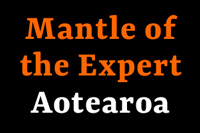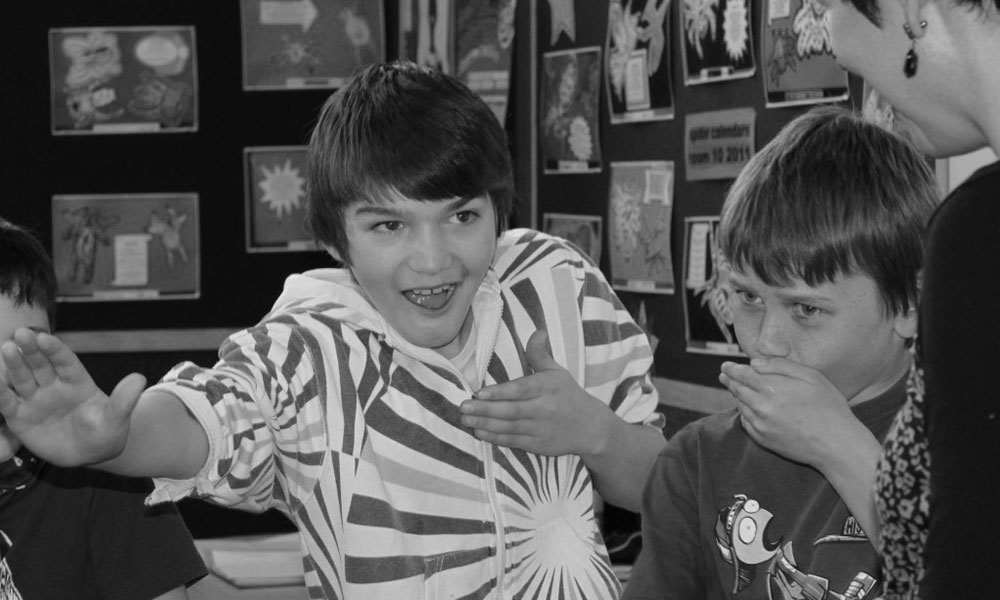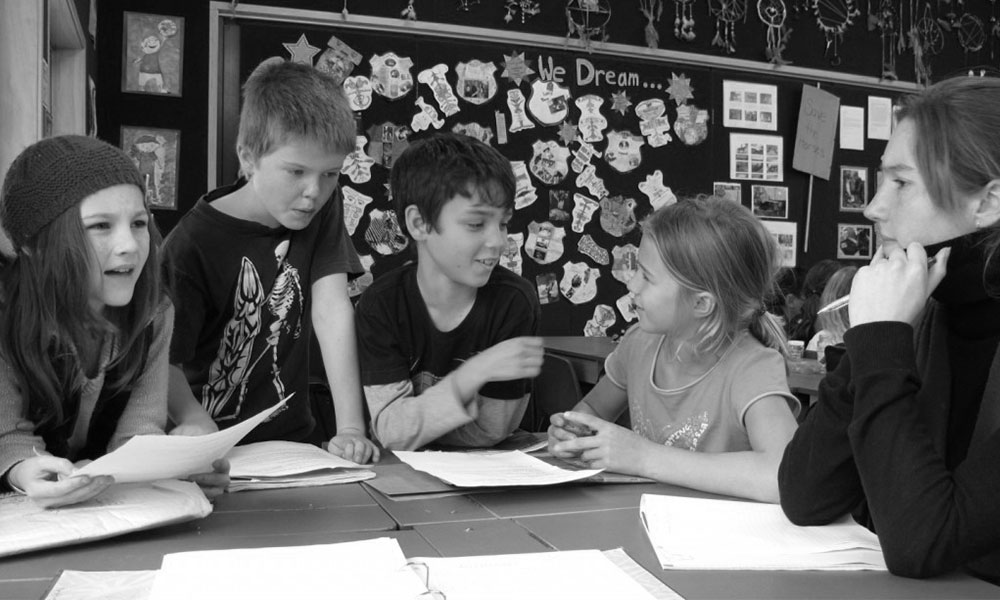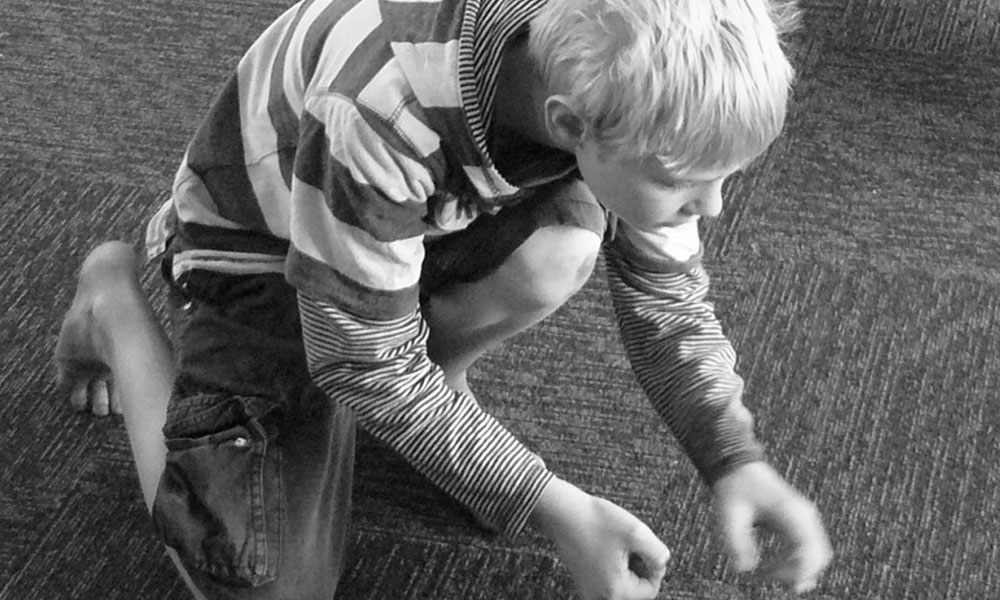What is Mantle of the Expert?
an active, urgent, purposeful view of learning, in which knowledge is to be operated on, not merely taken in
Dorothy Heathcote
First developed by internationally renowned educator Dorothy Heathcote, Mantle of the Expert is an approach to teaching and learning which combines inquiry learning, with imagination / drama, and powerful positioning of students. The approach is used in schools all over the world, including here in Aotearoa New Zealand, where it continues to evolve in line with our unique cultural context. Mantle of the Expert has close links with dramatic play, process drama and drama for learning as well as other dramatic inquiry approaches.
In Mantle of the Expert, children learn by agreeing to imagine they are experts engaged in a high status commission for a fictional client. For example, they might spend a morning imagining they are commissioned by the head of a marine sanctuary to design a world-class sanctuary for injured dolphins. Or they may spend several weeks imagining themselves as museum curators with a commission from a local historical society to produce an interactive exhibit on an important incident from the past. Mantle of the Expert experiences can be brief (within a single lesson) or sustained (over several weeks to a term, or longer). The teacher draws on strategies and conventions from storytelling, drama, theatre and other arts, to move in and out of the imagined world with the children and to explore multiple perspectives.
As experts within the imagined world the children encounter authentic tasks and solve realistic problems related to the commission. This is where the inquiry comes in: the teacher carefully plans some tasks from the outset while others arise as a natural consequence of the work at hand. Children have a lot of agency within the boundaries of the commission. As dolphin sanctuary designers, for example, children might research the habitats of particular animals, draw up a design plan for the new enclosures, work out the weights, volumes and costs of food, write press releases appealing for funding, create a scene in which they imagine the capture of the first injured dolphin and so on. As museum curators they might research local stories, record soundscapes for the displays and design educational materials for children visiting the museum.
In this way, instead of learning within discrete curriculum ‘boxes’, children develop skills and deepen knowledge in literacy, numeracy, languages, the arts, technology, social sciences, health and physical education within meaningful contexts, with a clear purpose, and with many rich opportunities to work with and learn about IT. Curriculum tasks are framed as professional tasks required for a clearly identified purpose. Put simply, Mantle of the Expert exposes learners to new skills and knowledge in the way that life does and as such provides an exciting and authentic motivation for learning.
The fictional nature of Mantle of the Expert is critical to its potency as a learning tool. First of all, Mantle of the Expert taps into children’s capacity for socio-dramatic play (‘pretending’ games). Not only does this build engagement and make learning fun’, it also aligns to the child’s own way of learning about the world. Imaginative play is critical to children’s development and is key in how younger children build an understanding of their wider world. Research has also shown that, properly supported, this kind of play continues to be beneficial right through to adolescence. One of the keys to the success of Mantle of the Expert is that in many ways, imagined worlds offer more opportunities for agency than everyday reality does. By keeping the commission firmly in the fictional world, children can experience a rich combination of safety and challenge. Participants are able to make high status decisions and face difficult problems with the knowledge that while these really ‘matter,’ there are no real world implications.
Aotearoa New Zealand has a long-standing association with the work of Dorothy Heathcote, who was patron of the drama subject society Drama NZ (NZADIE) until her death in 2011. Heathcote’s visits to the country in the 1970s and 1980s had a profound influence on the children, teachers and academics who worked with her as well as on the direction of curriculum development in this country (Holland & O’Connor 2004). It was on her visits to Aotearoa New Zealand that Heathcote first developed what would later become her Mantle of the Expert approach.
Over the years increasing numbers of teachers around NZ have studied the Mantle of the Expert approach through university courses and in-service professional development. Increasing numbers of individual teachers now use Mantle of the Expert regularly in their classrooms, and more and more schools are embedding Dramatic Inquiry (including Mantle of the Expert) within their local curriculum.
This is an exciting time for Mantle of the Expert in New Zealand. We have a curriculum that encourages teachers to explore new and innovative pedagogies with key competencies at the forefront. We’re also seeing a new focus on localised curriculum, including the teaching of local stories and histories. And, of course there’s an urgent need to prepare our young people for the uncertainties and ‘wicked problems’ faced by humans around the globe. With Mantle of the Expert to make teaching and learning integrated, authentic, and engaging we can help learners to become creative, critical, empathic and collaborative citizens of the twenty-first century.
by Dr Viv Aitken. Adapted from NZ Education Review article July 3 2009.
References:
Forester, K. Call in the Experts TES Magazine, 19 May 2006
Holland, C. & O’Connor, P. (2004) Like Writing off the paper: Report on Student learning in the arts NZ Ministry of Education: Research Division
Other quotes sourced from www.mantleoftheexpert.com
What do teachers say about Mantle of the Expert?
To me it is a very important form of inquiry learning. Using drama – kids develop more empathy when studying countries or scientific ideas or whatever. It’s that empathy that I’ve really come to appreciate. You just don’t get that through any other form of inquiry.
RM – Primary school teacher
One of the features is that it steps children up into leadership and being more grown up. They don’t just talk about being an expert – they become an expert. Power sharing is huge. It allows children to go down pathways as experts and that is rare for children to have so much power.
GG – Deputy Principal
It encompasses everything about the ‘effective teacher profile’ … Co-construction, student voice and the acknowledgement of cultural capital and prior knowledge. This is so key – particularly for our Māori and Pasifika students – to believe their own knowledge base is important.
KW – High School teacher
I have used Mantle to achieve accelerated literacy results at my school and I am currently working alongside two teachers who are really excited to be using this unique pedagogy that not only engages students but achieves academic results.
SB Deputy Principal
Where can I read more about Mantle of the Expert?
Mantle of the Expert – a brief introduction from Fraser, Aitken & Whyte Connecting Curriculum, Linking Learning Wellington: NZCER.
Real in All the Ways that Matter: Weaving Learning across the Curriculum with Mantle of the Expert (Aitken, 2021)
A Beginner’s Guide to Mantle of the Expert (Taylor, 2016)




